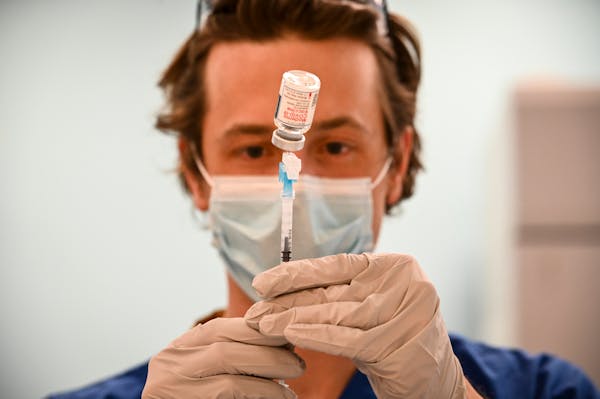Disparities in COVID-19 vaccination have persisted in Minnesota, but equity advocates hope a recent expansion in eligibility will steer more doses to minority members who have suffered higher rates of severe illness and death.
The latest Minnesota Department of Health data showed that Black people make up 6% of the state's population but 3.5% of its vaccine recipients. The COVID-19 death rate for Black people is more than twice that for white people when adjusting for differences in the average ages of the two groups in Minnesota.
A disparity was inevitable with the focus of COVID-19's initial vaccine distribution being on vulnerable senior citizens, because Minnesota's elderly population is disproportionately white, said JP Leider, a University of Minnesota researcher who has analyzed disparities in COVID-19 cases and deaths. However, the recent expansion to 1.8 million non-elderly adults based on their occupations and underlying health status provides an opportunity to even that out.
"It's time to play catch-up in a really big way," said Leider, who served on the state's vaccine allocation advisory group. "Within this enormous new group of 1.8 million people, how do we drive uptake in the communities we're most worried about?"
Pandemic indicators remain stable in Minnesota, where the positivity rate of diagnostic testing has remained below a caution threshold of 5% for two months, but the state saw slight increases in diagnosed infections and hospitalizations over the past week.
The 829 newly confirmed infections and one COVID-19 death reported on Monday brought Minnesota's totals in the pandemic to 498,218 infections and 6,747 deaths.
New variants of the SARS-CoV-2 virus that causes COVID-19 have raised concerns, though, even as the state on Monday relaxed restrictions on bars, restaurants and group gatherings.
A B.1.1.7 variant has been confirmed in 251 infections in Minnesota and is central to an outbreak among youth sports participants in Carver County.
Of the 140 cases in that outbreak involving young athletes, coaches, referees and household contacts, 32 have been linked through genomic sequencing to the variant, with results for another 67 pending. Cases in that outbreak include 12 people who were hospitalized and two deaths.
The B.1.1.7 variant appears 50% more infectious than initial strains and potentially leads to more severe illness, said Dan Huff, assistant commissioner for the state Health Department. "It has the potential to be a setback to our continued and hard-fought progress against the virus."
Vaccine appears effective against that variant, and that's good news for the at-risk populations in Minnesota that have had substantial access. So far, 76% of the state's senior citizens have received COVID-19 vaccine, which has been offered in every nursing home.
The state on Monday reported that 1,260,771 people in Minnesota had received the vaccine, and 724,692 had completed the series either by receiving two doses of the Pfizer and Moderna versions or a single dose of the new Johnson & Johnson vaccine.
However, unvaccinated at-risk populations could be exposed to another wave of COVID-19. Even among Minnesota's senior citizens, the vaccination rate is 49% lower in Hispanic people compared with white people, and 19% lower among Black non-Hispanic people, Leider said.
Minority members age 45 to 64 probably should have received access to vaccine much earlier, he added, because their rates of severe COVID-19 are much higher than for white people in the same age range. The latest expansion of vaccine access will help and also allows for vaccination of people 50 and older from multigenerational homes — which are common in minority communities and also increase viral transmission risks.
Allina Health sought to address the disparity this weekend by offering 800 appointments for the single-dose J&J vaccine in Minneapolis. The provider sought minority and lower-income patients from the surrounding Phillips neighborhood.
The event was a learning opportunity for Allina, because word of the opportunity got out beyond the targeted neighborhood, said Vivian Anugwom, Allina's health equity program manager. State health officials also raised concerns that it was providing appointments to people who weren't yet eligible.
In the end, more than 20% of recipients were 61 or older and 80% were from the targeted neighborhood. Screening at the door ensured that all recipients were eligible based on their health, occupations and ages, though that meant turning some people away and finding workers in the nearby Allina Commons shops who were eligible and willing to be vaccinated instead.
Despite concerns of vaccine hesitancy in minority groups, Anugwom said there was tremendous interest once people were given the opportunity to ask questions about the vaccine and receive an invitation.
"Someone said, 'Wow, you've just given me my freedom,' " she said. "Folks were ready to get the vaccine and ready to move on from this."
State Health Commissioner Jan Malcolm said the disparity is being targeted through vaccine events at federally qualified health centers in Minnesota that are reaching out to minority communities.
Mobile vaccine clinics are being set up to offer vaccine to people with limited transportation options, she added.
Data showing vaccination by race have been publicly available for only two weeks and will help steer community clinics where they are needed, she added. "Having better data is going to help us measure more precisely where we are making progress and where we have work to do."
Jeremy Olson • 612-673-7744

Trail section at one of Minnesota's most iconic spots closing for rehab

Will 'shotgun only' zone for deer in southern Minnesota be abolished?

Four Minnesotans catch salmonella in outbreak linked to basil sold at Trader Joe's

